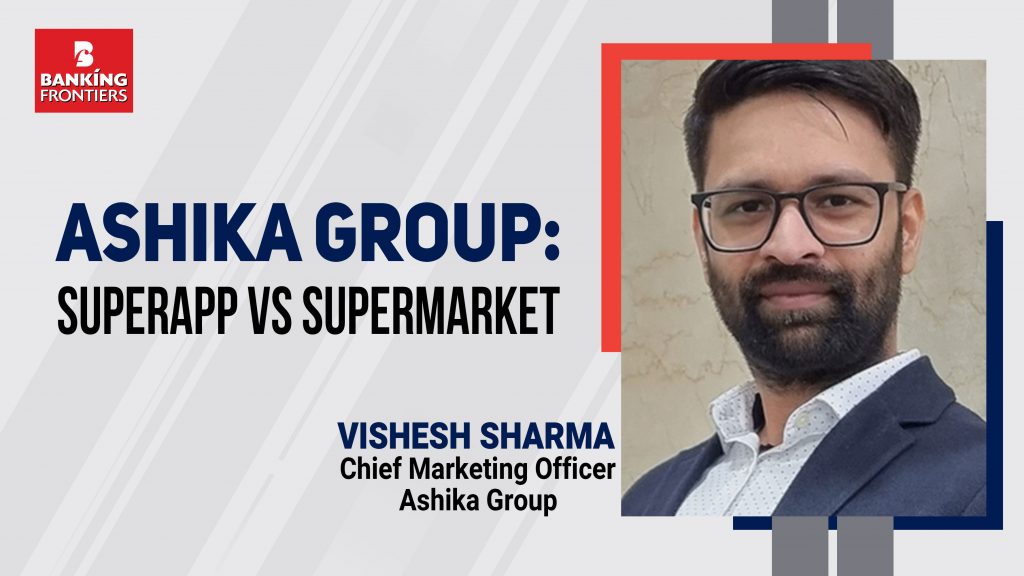Vishesh Sharma, CMO at Ashika Group, shares the strategies adopted by the company for superapp vs supermarket:

Ravi Lalwani: What has been the impact of super apps on the financial sector so far?
Vishesh Sharma: The super app ecosystem in India is still in its nascent stage. In the last few years, many fintech players have integrated multiple financial services and products like FDs, mutual funds, and equities in a single app. It has undoubtedly improved user experience by enabling investors to carry out multiple tasks through a single platform.
Since most of these platforms focus on tier 2 & 3 cities, it has helped ensure financial inclusiveness and enabled people to diversify their investments to an extent without much hassle. As per a report by BSE, registered demat accounts have grown 10X, from 10 million in 2008 to 100 million in 2022. This ongoing growth can be attributed to the rise of new age fintechs that offer different investment products on a single platform.
The AUM of the mutual fund industry in India increased 5X from Rs7.20 trillion on September 30, 2012, to Rs38.42 trillion on September 30, 2022. This growth momentum across asset classes will potentially continue as fintechs finetune the super app ecosystem and users get access to hassle-free investments as well as quality financial education.
What differences in the impact of super apps do you expect in 2023?
Super apps have the potential to truly transform the retail investing segment, provided they offer users the ease of investing it promises. While many fintech players have initiated the integration of different services for building a super app, it is as crucial to consider the efficacy of user experience. For instance, if an app takes users to different web pages for each service via third-party integrations, it negates the core objective of a super app.
Fintech players should focus on building an all-encompassing ecosystem for all the services. Users should be able to access all services on a single platform rather than visiting different landing pages.
Parallelly, relaxation is needed in the regulatory framework for the BFSI sector to provide a unified experience through super apps. For instance, we all know the sentiment Indians attach to gold as an investment option. As a result, some broking houses initially provided the option of buying and selling gold on their platforms but were forced to discontinue the service due to regulatory concerns. Now, these instances can have a bearing on the final product offered to the customer. I think it’s high time for all regulatory bodies, including RBI, SEBI, IRDA, AMFI, etc., to agree on standard regulations. Regulations must become dynamic according to market trends and requirements.
How is Ashika group gearing up to offer its customers a super app and how it will be different from the competition?
Now-a-days, if you look around, practically every BFSI player aims to build a superapp based on their existing ecosystem. While there’s no concrete definition or framework for a superapp, everyone is building a platform that they feel will provide a hassle-free experience to existing and prospective customers. However, we at Ashika Group are not just looking to offer a superapp but a full-fledged financial supermarket through our retail app Dhanush. Once delivered in totality, we are certain that this app will disrupt the financial markets like never before since we are probably going beyond just a superapp. And as far as I am aware, no one in the market has been talking about the financial supermarket as a concept.
Briefly describe what your organization has done for this opportunity.
Fintechs are building what’s convenient to them instead of what consumers want. Not many independent surveys now-a-days talk about superapps from a customer viewpoint. It is important to understand that an investor needs much more than a cosmetic superapp. This is where a financial supermarket platform like Dhanush comes into the picture, where investors will not only get what’s being offered presently, like equity, mutual funds, US stocks, and FDs but also products like fractional investing, retail startup investing, unlisted shares, and green investment products, to name a few.
This proposition will empower customers to choose from multiple products based on their investment philosophy and core value systems. While everyone is talking about superapps, we are already building the next concept for Indian investors in the form of a ‘financial supermarket’. It will disrupt the BFSI space massively.
How is supermarket marketing different from normal app marketing?
When planning a campaign for a single service app, identifying the nudge points and communication routes is easy. However, for an app like ours that offers multiple products to different audience segments, one has to rely heavily on automation tools to understand user behavior and preferences. It is like adding data science to the art of storytelling, where you create brand positioning and use analytics to target the right audience for the right product. After this, it is about running sub-campaigns under one big umbrella campaign. However, your job is half done if you have built a remarkable product that offers a hassle-free user experience since this is precisely what marketing needs. Once this is achieved, it is all about communicating and making people aware of the app. This is why my team is working very closely with our technology and product teams to develop the platform. I am extremely bullish on them delivering a truly transformative financial supermarket through our app Dhanush.
What quantum of marketing do you think is required for superapp and supermarkets to reach a tipping point?
Marketing quantum varies from brand to brand, majorly based on a particular brand’s objective. Another important aspect is how aggressively a brand wants to play and what aspirations one has for the product. Some fintech players just focus on acquiring numbers while remaining indifferent to the activation ratio. I know of some stock broking houses that just focus on getting leads and converting them without even realizing that they won’t even be able to extract acquisition cost, let alone do business with these customers. Similarly, some organizations are clear that they want to focus on quality customers. So, you can’t have a one-size-fits-all marketing strategy.
At Ashika, we are focused on building trust among our customers, as investing is all about trusting the right partner and sticking around for ages. Fortunately, even our promoters agree that we don’t have to be in any rat race to create value for our customers. As a result, our activation ratio and ticket size per customer are among the best in the industry. Through our marketing efforts, we are building an organic ecosystem that will give the organization sustainable and scalable growth. And yes, automation and analytics will play a significant role in delivering this growth.
______________







